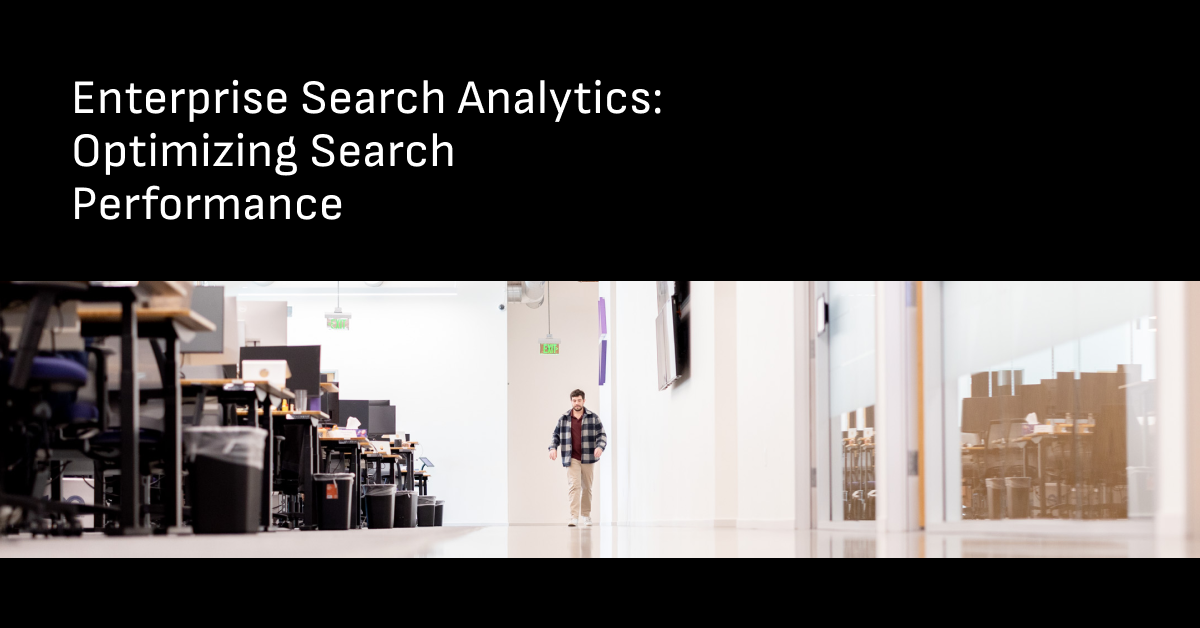Table of contents
Imagine you’re planning a work trip: how many different kinds of information and systems would you need to access just for this one task?
You might need to check your company’s travel and reimbursement policies (what system were those in again?), log into an expense management platform, and find a deck for your presentation too.
Wouldn’t it be great if you could just search across your companies’ applications to immediately find your updated travel policy instead?
That’s the power of enterprise search. Enterprise search helps organizations efficiently search for and access information within corporate environments.
Enterprise search is a powerful tool, and even more so when grounded in analytics.
Enterprise search analytics provide metrics on the performance of your search tools so you can understand what's working and what can be improved. These metrics often include search accuracy, retrieval speed, knowledge resource usage, and much more.
With a strong enterprise search analytics tool, you can better identify knowledge gaps, make data-driven decisions, improve your search performance, and enable your employees to make smarter decisions.
Understanding enterprise search analytics
Enterprise search analytics involves the collection and analysis of data related to enterprise search. These metrics typically include search queries and user interactions within an organization's search platform, providing insights that help improve content discoverability, user experience, and search efficiency.
Relying on these real-time analytics helps you gain deeper insight into how employees actually engage with your system—and whether they get the results they need.
Armed with these insights, you are able to better optimize your enterprise search software to improve your retrieval speed, information relevance, and ultimately the user experience too.
How do enterprise search analytics work
Enterprise search works by indexing vast amounts of data from various sources within an organization, such as documents, databases, and intranet sites, to create a searchable repository.
When a user inputs a query, the search engine utilizes algorithms to quickly retrieve and rank relevant results based on factors like keyword relevance, metadata, and user behavior.
Analytics on enterprise search gather data from user search behaviors, such as query frequency, click-through rates, and time spent on results, to provide insights into what users are seeking and how effectively the search engine is meeting their needs.
Next, the software further analyzes this data by looking at various metrics, including:
- Search volume
- Search accuracy
- Search refinements
- Query performance
- User satisfaction
- Click-through rate
- Zero-result searches
- Time to result
- Content gaps
This information is typically aggregated and visualized through dashboards or reports, allowing administrators to identify trends, such as popular search terms and content gaps, and to understand common user paths.
By examining these analytics, organizations are able to refine their search algorithms, improve content relevance, and enhance the overall search experience, making it more intuitive and efficient for users.
Understanding AI-powered enterprise search
Search platforms that incorporate artificial intelligence (AI) technologies, like machine learning and natural language processing (NLP), are able to enhance accuracy, offering personalized results and predictive search suggestions to improve the overall user experience.
AI is advancing search analytics by interpreting user context, identifying patterns in real time, providing actionable insights, and more. How does it do this?
- Data integration and indexing: AI-powered search aggregates and indexes data from diverse sources within an organization for easy accessibility.
- Natural Language Processing (NLP): It uses NLP to interpret queries naturally, retrieving results that match user intent and context.
- Personalization and contextual relevance: The system personalizes results based on factors like user input or domain, offering contextually relevant suggestions and refining searches over time.
This aids your organizational decision-making and helps you continuously improve the user search experience.
Key metrics in enterprise search analytics
Let’s dig a little deeper into some of the most essential metrics involved in search analytics:
- Search volume and trends: Search volume is simply how many searches have been performed in a given time period, while trends refer to queries or topics that are being frequently searched. These metrics can help you prioritize the types of content that employees need or want.
- Click-through rates (CTR): CTR is the percentage of searches where the user clicks on a result. It goes hand-in-hand with result-ranking effectiveness, which indicates how well the search engine orders the search results. (A high CTR generally equals more relevant results.)
- Failed searches: This metric highlights potential content gaps — there’s a topic employees are searching for that’s not turning up relevant or updated results. So you’ll need to either create content to answer that query or tag/organize existing content to make it more findable in search results. (An AI-powered enterprise search solution may offer automation for tasks like these.)
- User behavior insights: These include patterns like queries, bounce rate, session time — anything that shows how people interact with search. They help you improve personalization and user experience.
- Search refinement: A search refinement is when a user types in a phrase to search, isn’t satisfied with the results, and amends their original phrase to search again. This falls in line with the broader metric of user satisfaction and can also help identify content gaps or poor organization.
Common challenges in enterprise search analytics
From increased productivity to better decision-making, effective enterprise search can benefit your organization.
However, you may find yourself navigating some challenges that, left unaddressed, lead to reduced performance, including:
- High information retrieval times: If your search solution isn’t well integrated — or is full of content that’s outdated or unorganized — it may lead to slow, frustrating load times that affect productivity.
- Irrelevant search results: You might also find that searches pull up content that’s outdated or simply unrelated to the search query, which may reduce confidence in the tool over time.
- Missing metadata: Enterprise search systems tag and index content with metadata. So content that isn’t indexed correctly or comprehensively may become difficult or impossible to find via search.
- Siloed knowledge across multiple platforms: A good enterprise search platform will integrate across your business environment to pull from multiple data sources for every search query. If yours doesn’t, employees will be forced to manually search across wikis, CRMs, email, Slack, document drives, and other sources.
- Limited visibility into search performance: Analytics provide the visibility needed to understand and improve search performance and optimize search results, leading to poor user experiences and limited adoption.
There’s a common misconception that enterprise search analytics primarily measure search performance. But they can go far deeper than basic performance metrics. You’ll also be able to gain rich, valuable insights into areas like:
- User behavior: Search refinement, click-through rate, bounce rate
- Content gaps: Queries that return no results
- Information accessibility: How easily employees can find the knowledge they need
Still, enterprise search analytics aren’t a magic, quick-fix solution. Even with an AI-powered system, where many key features are automated, it still takes ongoing data analysis and fine-tuning to achieve optimal performance.
You’ll also need to integrate your search system with other platforms, such as your CRM, help desk, and knowledge base or document management system. These integrations can take time to set up and get right before you start seeing real results.
How enterprise search analytics improve knowledge discovery
Enterprise search analytics give you a constant stream of data about what users are looking for and what they’re finding (or not finding). These analytics can help improve knowledge discovery by revealing patterns — showing you which documents are accessed most frequently and how users are finding them.
Analytics can also help you better curate your knowledge repository by revealing knowledge gaps, inefficiencies, and outdated content, giving you feedback on what you need to create, update, refine, merge, archive, or better categorize.
And the improvements you make have a direct impact on employee productivity, reducing their search time and ensuring they have on-demand access to the accurate information they need.
Tracking and analyzing search behavior
Search analytics are able to log user searches, allowing the system to then analyze the information and pull out valuable insights. For example, real-time analytics based around user queries give you visibility into information like:
- High-volume searches and trending topics: If you notice that “remote work policy” has suddenly become a top search, that may signal you need more clarity or visibility around your remote work guidelines.
- Failed searches: Users looking for “travel reimbursement form” might be receiving no results because the document is titled “expense claim request.” This would point to a lack of proper tagging and metadata.
- Search refinement: Analytics can show you how users refine their searches (e.g., searching for “benefits,” then “health insurance,” then “vision plan coverage”) when they receive unsatisfactory or no results. Understanding how users are looking for and ultimately finding information helps you refine the search experience.
Identifying and filling content gaps
Enterprise search analytics also help you discover gaps in content, where the information users are searching for is outdated, insufficient, or missing altogether. You can find these content gaps via search analytics like:
- No-result searches
- Low-click searches
- High bounce rates (high search frequency, but many search refinements or a short dwell time)
Content gaps and inefficiencies become a lot easier to manage with an AI-powered system. Artificial intelligence is able to recognize search history trends and understand the intent behind those searches.
The system can then either send you a notification prompting you to add content to the knowledge base to address these topics, or some advanced tools are able to suggest or generate an article on its own, pulling relevant information from existing resources.
Best practices for implementing enterprise search analytics
Your IT team and knowledge managers will need to configure your enterprise search analytics before they can begin effectively collecting data. If you’re working with an AI-powered platform, many of the following best practices will be automated.
There are some areas (like defining KPIs that align with your business objectives) that you should give some thought to before you’re ready to jump in.
Setting up search analytics for success
Let’s walk through a few key steps that will help you configure search analytics in the best way possible. This will help you reap the full benefits of efficient knowledge discovery, better content management, and smoother, quicker knowledge retrieval.
- Define KPIs for search success: First, you’ll need to define what success means (e.g., reduce failed searches by 30%) and select the relevant key performance indicators (KPIs) you’ll use to measure it, such as:
- Search usage or engagement
- Platform adoption
- Search accuracy or relevance of results
- Reduced support ticket volume
- Hours of productivity gained or time saved
- Ensure proper data indexing and metadata tagging: Employees may not be able to find content unless it’s properly organized. All content sources, including structured and unstructured data, should be indexed in your search platform. Make sure all documents have consistent metadata and that outdated content is archived.
- Enable AI-powered relevance ranking and auto-suggestions: Enterprise search can use machine learning (ML) to improve result relevance and natural language processing (NLP) to interpret user context and provide richer results (more in this next). AI can also help provide auto-suggestions and query expansions.
- Integrate with other enterprise systems: Connect your enterprise search platform with your other workplace applications, like your CRM, intranet, helpdesk, document management tools, email, etc. The search engine is generally most effective when it is able to pull from various data sources, and you’ll receive deeper insights to learn from.
- Establish governance and ownership: Clearly define who’s in charge of handling the search analytics tools and implementing necessary improvements. Also, create policies for tagging and updating content in the knowledge base.
Leveraging AI for smarter search optimization
There are two primary approaches when it comes to enterprise search technologies — traditional search and AI-powered search. Each has its own unique ways of accessing, distribution, and updating information from across an organization's data repositories.
Traditional search
Traditional enterprise search follows the classic model of full-text indexing document contents and metadata to match against a user's keyword queries. It builds an inverted index that maps words to their locations within text sources.
Results get ranked by factors like term frequency, proximity, and other simple relevance signals extracted during indexing. While effective for finding word patterns, traditional search lacks deeper language understanding capabilities possible with more advanced tools.
Traditional enterprise search analytics may have less relevant results and require users to manually update information and sift through dashboards. These tools may not fully capture the context or intent behind queries, requiring more effort to derive actionable insights from search data.
AI-powered search
AI search uses machine learning to understand the context of your queries and surface the most relevant results, even if your keywords aren't perfect.
It can even generate summaries of the information you need and suggest actions based on your findings. This allows for more natural, conversational search interfaces and the ability to reason over broader topics and related concepts — not just matching words.
AI-powered search analytics are able to utilize natural language processing to better understand user intent, providing more accurate and context-aware results. These systems can evolve from user interactions to enhance and personalize search experiences, can suggest information or articles to be updated, for a more proactive and personalized approach to search.
Real-world impact of AI-powered search analytics
Companies around the world are already using AI assistants with search functionality to streamline operations and enhance productivity. One example is Broadcom, a global technology leader that develops semiconductor and infrastructure software products.
During a period of rapid growth and multiple acquisitions, Broadcom faced a surge in IT support requests and the challenge of managing knowledge spread across 10 different systems.
To address these growing pains, the company sought a smarter way to connect employees with the information they needed.
Broadcom turned to Moveworks for help, implementing its AI Assistant , to bridge the information gap, quickly surface information, and deflect routine IT tickets.
The AI assistant quickly became a key part of the company's broader digital support strategy. Since deployment, Broadcom has reported:
- 57% of IT issues resolved autonomously
- 75,000 total IT issues resolved (and counting)
- Employees instantly find answers from knowledge base articles
While Moveworks AI Assistant wasn’t the only factor in Broadcom’s success, it played a significant role in helping the company scale its support services and improve the employee experience.
How Moveworks enhances enterprise search with AI-powered analytics
If you’re in the market for an enterprise search platform, selecting an option that incorporates AI-driven features and robust analytics is key.
Moveworks Enterprise Search leverages agentic AI to deliver the trustworthy and accurate answers that employees are actually looking for.
- Enterprise-ready: Get up and running without compromising requirements around scalability, reliability, security, or analytics.
- Personalized answers: Combine agentic RAG with robust permissions and AI ranking to deliver the most tailored and useful results for each employee.
- Make search actually helpful: Bring a goal-driven approach to information retrieval. Results are instantly summarized and cited for accuracy.
- Integrate all your systems and data with 100+ connectors, or easily build gateways to custom content sources.
- Granular permissions & access controls so that employees can only see what they have access to (and nothing more)
- Robust analytics: Get usage insight and utterance-level visibility to understand key metrics around user trends, in-demand topics, and content quality.
Enterprise search analytics can continuously offer insights and optimization recommendations to enhance your search performance, improving your decision-making – and elevating your employee productivity too.
Learn more about why AI-powered search analytics are the solution to your enterprise search challenges: See Moveworks in action.



